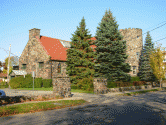A Little Journey to the Roycroft Campus

It is a story myths are made of.
A young corporate executive cashes in his entire stockholdings, leaps off the corporate ladder to pursue his dream of becoming a writer and starts his own publishing company in a drafty horse barn. He develops the Midas touch, expanding his business by hiring talented staff members, developing new marketing techniques and becoming a national celebrity.
But, like a figure in a Greek tragedy, he has his Achilles heel. He takes a lover, for ten years denies the child he fathered and, when exposed, becomes an outcast. The press which once hung on his every word turned on him, his neighbors shunned him, his frail wife and four young children seem stunned by the revelation of the double life their husband and father had been living. But he holds fast to his dream, weathers the storm he brought down on himself and presses forward.
More words have been written about and by Elbert Hubbard than any other figure in the American Arts & Crafts movement. His mark – the letter “R” within the orb and cross – is the most recognized of all the shopmarks collectors study today. And while we await the arrival of the researcher prepared to write the definitive biography his life so clearly deserves, we have the opportunity to walk the grounds of the Roycroft Campus he created in East Aurora and wander through the buildings Elbert Hubbard constructed to house the many facets of the Roycroft Shops.
His fatal decision to book passage with his paramour and second wife, Alice Moore, to Europe aboard the Lusitania in 1915 is familiar to most Arts & Crafts collectors. The task of following in his father’s footsteps fell to his son Bert, who guided the Roycrofters through the dark days of the Great Depression, only to finally fall in 1938. For the next fifty years the dozen or so buildings on the Roycroft Campus fell into the hands of a dozen different owners, some carefully maintained, others allowed to slowly deteriorate.
The reversal of fortune for the Roycroft Campus began in earnest in the 1970s, but progress came in frustrating spurts, hindered by the lack of funds to restore the decaying structures, along with a central plan to make them financially profitable. Adding to their frustration has been – and continues to be – the strident, emotional and contrary beliefs among the present-day building owners as to how the Roycroft Campus should be organized and managed.
Today’s efforts to preserve and restore the Roycroft campus are being directed by the Roycroft Campus Corporation, a dedicated group of individuals who have taken a pragmatic, yet historic approach toward the revitalization of the campus. Spurred on by the reopening of the renovated Roycroft Inn in 1995, the R.C.C. has slowly and steadily made progress, not only in preserving and restoring several of the structures, but in getting maverick building owners to work with them.
A visit to the Roycroft Campus should be on every Arts & Crafts collector’s list, even – or especially – if you had been there years ago. My first visit was in 1986 and my most recent a year ago, and I marveled at the preservation and progress that I witnessed. Stone walls have been rebuilt and the grounds are well maintained; while not every structure has yet been restored, rampant decay has been halted.
Reserve a room at the Roycroft Inn, explore the old Copper Shop and Furniture Shop, and take a side trip into Buffalo to the Darwin Martin House Complex, five buildings designed by Frank Lloyd Wright during his Prairie School era.
It’s a trip back in time you won’t find anywhere else – and won’t forget.
For more information, go to www.RoycroftCampusCorporation.com.
And to www.RoycroftInn.com.
PS – Also check out http://www.buffalorising.com/2010/03/historic-roycroft-campus-gets-lit.html

– bj
